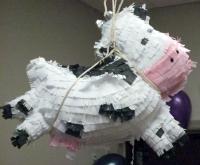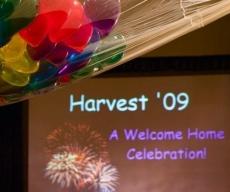Sometimes we need to take a break from the books to see the sky and the little things in the grass at our feet.
Creating artistic events and sacred spaces

What do tree branches, origami doves, beach balls, barbed wire and tulle netting have in common? As an artist, I’ve used them all to plan holistic conferences and create sensory experiences for students with different learning styles to encounter Jesus in fresh and innovative ways. When you’re planning your next event, use your artistic creativity to expand the richness of biblical truth for others who are hungry and thirsty for God — and watch what happens!
Do you remember this story from Dr. Seuss?
“One fish, two fish, red fish, blue fish,
black fish, blue fish, old fish, new fish …
Not one of them is like the other.
Don’t ask us why. Go ask your mother.”
“Not one of them is like the other.” We know this is true not just for fish. We are all made as unique beings, with special gifts, unique desires and different ways of seeing the world. Each one of us also has a special way of learning.
For this reason, over the last several years I’ve been incorporating this philosophy into the planning strategy for InterVarsity conferences in West Virginia, Western Pennsylvania and Metro Pittsburgh. We’re creating holistic conferences and events that appeal to people with a variety of learning styles and use all the senses to help students enter into a sacred weekend of meeting Jesus.
With a little creativity and some good old elbow grease, you too could create a mystical space to encounter God. Don’t let a limited budget discourage you. Search for items at yard sales, dollar stores or your parents’ garage.
Lavish love, lavish art
At a fall “Harvest” conference, the theme of the weekend was based on the story of the prodigal son in Luke 15. We focused on the father’s lavish love for his sons and God’s lavish love for us. To help students celebrate the son’s return to the father, we used  typical party symbols, with bright colors, balloons and a feast resembling a wedding reception. We had beautiful centerpieces, a giant cow piñata (our fatted calf) and fireworks. We gave a ring to every student to symbolize the love of God our Father. They took them home as a reminder of what God did throughout the weekend.
typical party symbols, with bright colors, balloons and a feast resembling a wedding reception. We had beautiful centerpieces, a giant cow piñata (our fatted calf) and fireworks. We gave a ring to every student to symbolize the love of God our Father. They took them home as a reminder of what God did throughout the weekend.
We also used classical paintings portraying the prodigal son to use as contemplative prayer pieces for the retreat of silence as well as decorations for the stage. Overhead, we sewed together yards and yards of white tulle netting left over from a wedding and used it as a net to hold hundreds of balloons. At the end of the conference, we released the balloons to begin our celebration.
During our large-group worship and teaching sessions, I worked on a large painting upfront and used it during the response time for students. I made the canvas out of a wooden pallet (free from a construction site) and attached several small pieces of plywood to it. The effect was that the painting looked like several small images combined into one. It portrayed little vignettes about God’s love for us. We gave students the opportunity to draw their own story of God’s love and add it to the painting during the final plenary session. This large painting (about 5' x 5') served as a tremendous visual of what we were learning. On the last evening, we triumphantly carried it out during the processional to the celebration, along with the fatted calf pinata.
One InterVarsity staff who attended the conference experienced new horizons in worshipping God through the arts. “God has gifted people to worship him in numerous ways, and the arts are just one more way that his message can go out to all the ends of the earth,” he said. “Our God is creative, inviting us to be a part of the process and to use our gifts — in this case, art. I’m learning to use art as an expression of praise.”
More ideas
Here are some other ways we have incorporated the arts — and the senses — in order to experience Jesus in a variety of ways at events:
- The theme of one conference was “Follow your Thirst” because we were reading the story in John 4 about the living water Jesus promised a woman he met at a well. In order to have students recognize their thirst for Jesus, we created physical thirst by giving them salty pretzels during our Bible study and then waited one hour to pass out water. They got the point!
- Another conference focused on prayer and the Holy Spirit so we made hundreds of brightly colored origami doves and strung them on fishing line overhead. The doves represented the presence of the Holy Spirit. Those attending the conference were encouraged to take one home to serve as a reminder of the role that the Holy Spirit plays in our lives.
- We often include a valued time of silence and reflection with artistic prayer stations or ways for students to creatively meditate on what God is doing in their hearts.
- Creative responses can be stimulated by different foods, showing movie clips or using music from popular culture. Also, we try to think of a tangible object that students can take home to remember their experience with Jesus (i.e. the doves, the rings, an iconic art piece they’ve created, a poker chip, a small rock, etc.).

Additional tips
When planning conferences, events or large meetings, consider these tips to incorporate creativity and the arts:
- Think about not only the space that the plenary sessions will be held in and how to decorate it visually, but also how students will interact with the passage and how they will physically engage with the theme throughout the weekend.
- Give adequate time to creative brainstorming and to prayer. Seek God’s heart about how to represent the truths of his Word. After all, he is the author of creativity. I typically begin the brainstorming process several months in advance of the event to creatively think about the theme and give input into the publicity materials. Often, the images or ideas from those materials will affect what I do for the event. Work with the planning team to understand the overall theme of the conference and invite others into the creative process.
- Don’t limit yourself to one particular genre of art. Think about using all forms: drama, dance, music, visual art, architecture, video media, interactive or installation art.
- There are many places where you can find awesome materials at a fraction of the price. Search thrift stores, garage sales, the dollar store, junk yards or your parents’ garage.
- Save what you use to recycle at another event. Most of the materials I used at the Harvest conference were from previous conferences but I reused them in a different context. It saves money and is more environmentally friendly.
- Think about space. To create an engaging atmosphere in a large room, you’ll need items that are relatively large. A visit to a local junk yard might be helpful or use items from nature such as tree branches, vines or rocks.
Conferences and events can be life-giving, transformative experiences for people to encounter the living Savior. Let the arts help you create sacred space for others that reflects the glorious Kingdom of our Creator God. Your artistic gifts may be just what people need to open their hearts to Jesus in new and imaginitive ways.
—Beth Roselius






